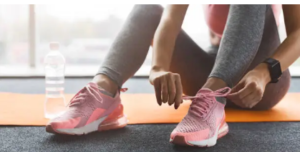Womens Shoes: Women’s Athletic Shoes
Womens athletic shoes are an ideal walking sneaker that combines style, comfort, and practicality – an easy slip-on bungee lace system and woven fabric upper make this shoe an excellent everyday option.
Shoe manufacturers understand this difference between male and female feet by designing shoes with different midsole and heel materials for each gender version of a model.
Comfort
 Womens athletic shoes provide optimal cushion, shock absorption, and support. It would be best to look for shoes that balance cushion, shock absorption, and support. A shoe that is too firm may lead to foot injuries, while one with too much flexibility won’t provide sufficient stability. A great fit is also essential, given that feet come in various shapes and sizes. Podiatrists advise selecting footwear that evenly distributes weight across your feet to avoid painful pressure points.
Womens athletic shoes provide optimal cushion, shock absorption, and support. It would be best to look for shoes that balance cushion, shock absorption, and support. A shoe that is too firm may lead to foot injuries, while one with too much flexibility won’t provide sufficient stability. A great fit is also essential, given that feet come in various shapes and sizes. Podiatrists advise selecting footwear that evenly distributes weight across your feet to avoid painful pressure points.
Women’s shoes tend to fit wider at the forefoot and narrower at the heel than men’s, leading to distinct construction techniques for running shoes designed specifically for each gender. Although many shoemakers use similar models across both genders, their construction considers these differences in shape – for instance, some brands might use different materials on heels of women’s and men’s versions of one model to accommodate wider foot shapes on women.
Reliability
Traditionally, running shoes have been developed with men in mind; their geometries and biomechanics were considered when designing these footwear models. Women’s feet differ significantly; they feature wider forefeet and narrower heels, which lead them to strike the ground differently from men. This condition, known as overpronation, may lead to injuries; therefore, women-specific running shoes use different materials to support the sole for cushioning purposes.
Sneaker brands have started taking notice of these differences between men’s and women footwear sizes. Instead of simply adapting a male-sized shoe for women use, some companies are designing sneakers specifically for female customers with gender-specific lasts and cushioning treatments to meet these unique demands.
Womens athletic shoes tend to be lighter because women weigh less than men, requiring less cushioning for support.
Are you searching for athletic shoes designed to withstand the rigours of your workout? Look no further than our vast inventory of womens sports sneakers – Vans, Converse, Adidas, New Balance, and more are available – you will indeed find what you need here! Shop now to find your ideal pair – free shipping and returns are available, so don’t wait – take on your workouts now and smash them out there.
Durability
The best womens sneakers are constructed of sturdy materials that withstand repeated use. Look for shoes with hard outsoles that last longer and spread wear across a larger surface area while their stitching resists constant lateral movement without wearing away their seams.
Walking is one of the best forms of exercise, but choosing shoes that properly support your feet while walking is essential to overall well-being. A pair of supportive footwear will shield and cushion your feet while giving them protection and cushioning over time.
Though many runners can wear shoes designed for men, finding something explicitly tailored to your unique foot structure is essential. Women’s feet don’t just differ in size from men’s; their biomechanics and hip width also vary significantly, leading to greater pronation and rolling inward when striking the ground more often on the outer edge of their foot compared to male counterparts – something manufacturers are beginning to accommodate when designing running shoes for female runners.
Value
Purchasing the appropriate footwear is essential to maintaining healthy feet. A poorly fitting shoe may cause foot issues and other health complications; running with footwear not specifically for running can make the activity extremely uncomfortable. For these reasons, women need to purchase footwear designed specifically for running.
Manufacturers have worked tirelessly to craft shoes explicitly tailored to men and women runners’ needs and preferences, considering differences in foot anatomy, shape, biomechanics of running stride, and aesthetic preferences. Women’s running shoes tend to have narrower heels while wider forefoot and toe areas due to women’s wider hips and Q angles than men.
